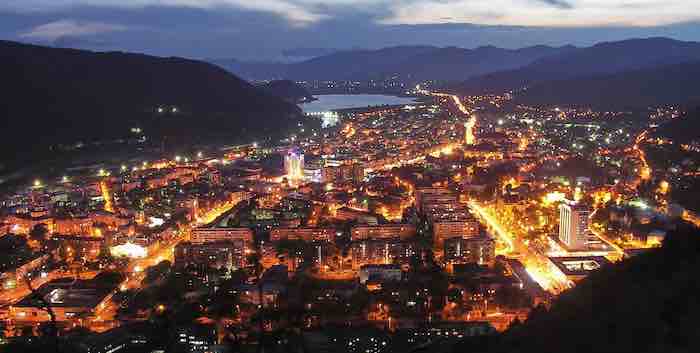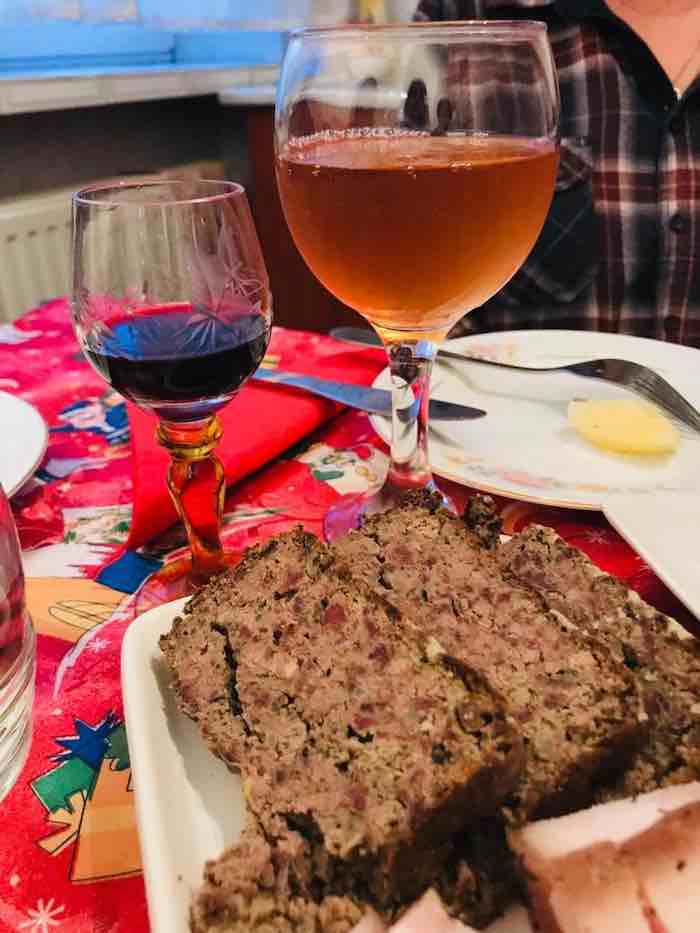Piatra Neamț, nestled at the eastern edge of the Carpathian Mountains
A Description of Romanian Winter Traditions

The harsh winters of eastern Romanian region of Moldova certainly pack a punch. Particularly in the city of Piatra Neamț, nestled at the eastern edge of the Carpathian Mountains, winter brings with it over two feet of snow from late November and lasting well into February. Alongside that, there are blood-chilling wind gusts arriving from Siberia that crash into the mountains. Icy streets and muddy roads make traveling all the more perilous. However, the season also brings with it a particular beauty. The evergreen trees on the mountains are covered with snow, hiding hibernating bears. The city is covered with bright lights welcoming the arrival of the Christmas season. Most interestingly, the smell of roasting sausage permeates the air.
Indeed, the terms warm and savory are two words that can perfectly describe the Romanian holiday season. It is during this season that the Romanian cuisine comes into its own and you will not find a table that is not filled with traditional dishes. At the center of Romanian cuisine is pork meat. There is even an old expression -
cea mai buna leguma-i porcu' (pork is the best vegetable) that serves as modus operandi of Romanian winter dishes. Around mid-late December, particularly on a day known as Ignat, many rural families sacrifice a fully-grown pig in a ritual that is known as
pomana porcului. The tradition has existed for centuries and may have originally been Dacian in origin.
No part of the pig goes to waste. The skin is fried into a type of pork rind that is referred to as
jumară. The pig’s internal organs such as the heart, liver, spleen, and kidneys are mixed with green onions and herbs to create a type of haggis that is referred to as
drob. The more savory and prized meat portions are smoked alongside freshly made sausage for days, ultimately baked in wine, and served as a meat stew called
tochitură moldovenească. This beloved meat dish is served alongside
mămăliga, a corn polenta, as well as a salty cheese that is called
brînza de burduf.
rved at the Romanian Christmas table such as pickled vegetables as well as the famous
sarmale – a minced meat and rice dish that is wrapped in cabbage or grape leaves and is recognizable from the Balkans to the Caucasus. However, the
tochitură serves as the center of the Romanian Christmas feast. All is prepared, of course, according to traditional recipes and tastes – heavily favoring garlic and onions.

For desert, there is the
turtă de julfă, which is a cake that is made with flour, honey, and hemp seeds. The dish has a religious significance in the Orthodox religion in relation to meeting the dietary requirements of seasonal fasting practices. The dish appears to be a local one, native to the northern Moldovan regions of Neamț and Suceava. Even there – the knowledge of preparing this dish is slowly being lost as fewer and fewer families continue to enjoy it during the Christmas season.
From my own experience, there are a couple of dinner etiquitte rules that must be followed that may come off as somewhat perculiar to Americans. Firstly, a guest is not allowed to refuse anything. Any attempt to suggest that one is full will be met with offerings of additional servings. Romanians tend to believe that guests will refuse their hospitality out of timidity or politeness so they feel that it is their sacred duty to insist. To continue to resist their overtures may eventually even be considered offensive.
Secondly, Romanians are heavy drinkers – and with it comes certain rules and responsibilities. The rule for not being allowed to refuse Romanian hospitality also applies here. When offered drinks, the key is to slowly sip on your beer or wine, and try to take as long as possible to finish your glass. Reason being – as soon as it is empty, it is the obligation of the Romanian host to refill it. The dangerous part comes when heavier homemade spirits such as
tuică and
vișinată are introduced into the celebration. Keep in mind that to drink is considered respectful, but to become drunk is to be considered a drunkard. Attempting to walk this cultural tightrope is an art form that takes years to master.

While feasting, it is not uncommon to hear a knock on the door, heralding the arrival of carolers. The singers are usually young people, often dressed in traditional clothing – singing carols, refered to as
colinde, that can either be religious or secular in nature. Traveling from door to door, families enjoy hearing their songs and afterwards rewarding the carolers with money, fruits, or sweets.
The winter is a time of not only the death and decay of the world, but also one of rebirth and renewal. In the regions of Neamț, Bacău, Iași, Suceava, and even in ethnic Romanian communities in Ukraine’s Chernivtsi region, the winter season is celebrated with parades and dances that hearken back to a more pagan past. These manifestations involve the dancing of people dressed as bears or goats following the beats of drums or the crack of whips. It is said that these dances represent humanity’s role in nature and its relationship with the animals. I do not know the Romanian name for these dances, but in Ukraine, the locals refer to them as
маланка (malanka).
These events follow the ancient practices of the old Romanian solar calendar. Its origins have been tied to Dacian, Romanian, Slavic, or even ancient Iranian worship, but they have since overlapped with the celebration of Christianity and the birth of Jesus. The ritualistic slaughtering of a pig, the communal feasts, the singing of carols, even the old pagan dances – they all celebrate the winter solstice and the year that has passed. They symbolize the rebirth of nature that will hopefully soon announce an end to the darkness of winter and the arrival of spring.
Darius Roby -- Bio and
Archives |
Comments
Darius Roby is a travel writer originally from the United States and is currently based out of Romania. He enjoys exploring the world from an ethnographic, historical, geographical, and culinary point of view. He regularly contributes to Cluj.com and Moldova.org. He is also a member of the American Geographical Society.
For other stories regarding travels around Romania and beyond, visit Darius’ website at Darius Roby
 The harsh winters of eastern Romanian region of Moldova certainly pack a punch. Particularly in the city of Piatra Neamț, nestled at the eastern edge of the Carpathian Mountains, winter brings with it over two feet of snow from late November and lasting well into February. Alongside that, there are blood-chilling wind gusts arriving from Siberia that crash into the mountains. Icy streets and muddy roads make traveling all the more perilous. However, the season also brings with it a particular beauty. The evergreen trees on the mountains are covered with snow, hiding hibernating bears. The city is covered with bright lights welcoming the arrival of the Christmas season. Most interestingly, the smell of roasting sausage permeates the air.
The harsh winters of eastern Romanian region of Moldova certainly pack a punch. Particularly in the city of Piatra Neamț, nestled at the eastern edge of the Carpathian Mountains, winter brings with it over two feet of snow from late November and lasting well into February. Alongside that, there are blood-chilling wind gusts arriving from Siberia that crash into the mountains. Icy streets and muddy roads make traveling all the more perilous. However, the season also brings with it a particular beauty. The evergreen trees on the mountains are covered with snow, hiding hibernating bears. The city is covered with bright lights welcoming the arrival of the Christmas season. Most interestingly, the smell of roasting sausage permeates the air. 
